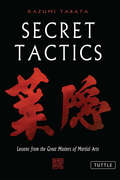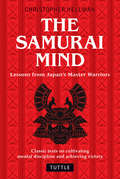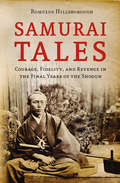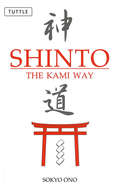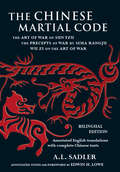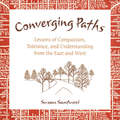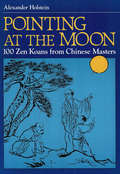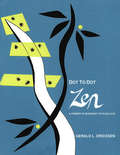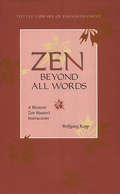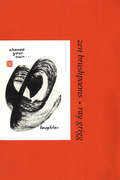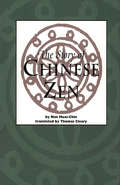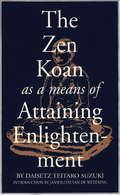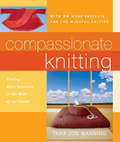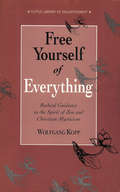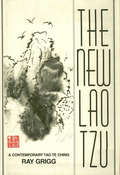- Table View
- List View
Secret Tactics
by Kazumi TabataIn the tradition of The Martial Artist's Book of Five Rings, one of America's most experienced teachers of karate offers new interpretations of fundamental martial arts texts. The book includes new translations of essays on leadership, correct behavior, character, and values. "Hereditary Manual of Fighting Techniques" by Yagyu Tajimanokami Munenori explores the relationship between Zen philosophy and warfare and the mental preparation for successful fighting. In "The Ultimate Sword," Takuan Soho describes the unremitting effort that must be undertaken to become a true master of strategy. He uses key aspects of sword-fighting strategy to shed light on the path to self-realization in "The Miracle of Immovable Wisdom." Kotoda Yahei Toshisada emphasizes the importance of training and learning techniques over theory in 'Technical Study of Kenpo." In "The School of Two Heavens," Musashi Miyamoto applies the principles of sword fighting to military arts and politics. Mastuura Saizan focuses on strengthening the weak points of the human mind, and exploiting the natural movements of the human body, in "Jyoseihi Kendan." And "Tengu's Dialogue on the Martial Arts" by Issai Chosanshi is a manual for students of the martial arts, presented in the form of a dialogue with a master.
The Samurai Mind
by Christopher HellmanThe Samurai Mind is a collection of five seminal Japanese texts which together convey the very essence of the traditional samurai warrior ethos. These texts range from the ferocious to the esoteric--with their common thread being the importance of mastering one's own mind as the key to overcoming opponents. Written from the mid-18th to early 19th century, the authors were acknowledged master warriors keen to address a broader audience beyond their circle of students and acolytes. Their aim was to explain their craft to the outside world, and they do so with great insight.
The Samurai Mind
by Christopher HellmanThe Samurai Mind is a collection of five seminal Japanese texts which together convey the very essence of the traditional samurai warrior ethos. These texts range from the ferocious to the esoteric--with their common thread being the importance of mastering one's own mind as the key to overcoming opponents. Written from the mid-18th to early 19th century, the authors were acknowledged master warriors keen to address a broader audience beyond their circle of students and acolytes. Their aim was to explain their craft to the outside world, and they do so with great insight.
Samurai Tales: Courage, Fidelity and Revenge in the Final Years of the Shogun
by Romulus Hillsborough Kiyoharu OminoSamurai Tales is about the legendary men from the samurai class who fought for the helm of power in 19th century Japan.<P><P> These are stories of courage, honor, fidelity, disgrace, fate, and destiny set in the bloody time of political change and social upheaval in the final years of the Shogun. Samurai Tales is, to quote author Romulus Hillsborough, "accurate portrayals of the heart and soul of the samurai, the social and political systems of whom have, like the Japanese sword, become relics of a distant age, but the likes of whose nobility shall never again be seen in this world." In recounting what he terms "the great epic which was the dawn of modern Japan," Hillsborough delves deeply into the psyche of the men of the samurai class. This book would serve well on the bookshelves of martial artists, those interested in samurai culture, or those interested in Japanese history.
Shinto the Kami Way
by William Woodard Sokyo OnoShinto, the indigenous faith of the Japanese people, continues to fascinate and mystify both the casual visitor to Japan and the long-time resident. This introduction unveils Shinto's spiritual characteristics and discusses the architecture and function of Shinto shrines. Further examination of Shinto's lively festivals, worship, music, and sacred regalia illustrates Shinto's influence on all levels of Japanese life.Fifteen photographs, numerous drawings and Dr. Ono's text introduce the reader to two millenia of indigenous Japanese belief in the Kami - the sacred spirits worshipped in Shinto - and in communal life, the way of the Kami.
Shinto the Kami Way
by Sokyo Ono William WoodardShinto, the indigenous faith of the Japanese people, continues to fascinate and mystify both the casual visitor to Japan and the long-time resident. This introduction unveils Shinto's spiritual characteristics and discusses the architecture and function of Shinto shrines. Further examination of Shinto's lively festivals, worship, music, and sacred regalia illustrates Shinto's influence on all levels of Japanese life.Fifteen photographs, numerous drawings and Dr. Ono's text introduce the reader to two millenia of indigenous Japanese belief in the Kami - the sacred spirits worshipped in Shinto - and in communal life, the way of the Kami.
Chinese Martial Code
by Edwin Lowe A. L. SadlerFor millennia the classics of Chinese martial strategy have been studied and their lessons applied with devastating success by warlords and military generals and today this timeless advice is analyzed as much for its application in the boardroom as on the battlefield-as thousands of Asian businessmen can attest.Chinese Martial Code provides clear, easy to follow translations of three of the most respected works on strategy in history, featuring a masterful translation of The Art of War of Sun Tzu--the most respected of all works of military strategy--as well as the less famous but equally wise Precepts of Ssu Ma Jang Chu and Wu Chi On the Art of War.Additionally, A. L. Sadler's translation is converted here into Pinyin for the first time and the original Chinese language versions of these classic texts are also included, making this title a treasure to Chinese history and military scholars as well. The text is also copiously annotated, placing its sage advice in perspective for modern readers planning to use these time-tested strategies to conquer the business world.
Converging Paths
by Susan SantucciIn Converging Paths, Susan Santucci gathers the world's greatest religious insights into one volume that is easy-to-read, thought-provoking, and inspirational. Each short-entry focuses on a single aspect of the wisdom shared by major world religions. Quotations from mystics, philosophers, and contemporary writers help readers make connections between traditional teachings and their own spiritual path. The result is a quick, clear introduction to spiritual traditions from around the world without lengthy, esoteric discussions. These wonderful examples of shared values and religious diversity will appeal to students of comparative religions and anyone seeking to further their spiritual journey.
Pointing at the Moon
by Alexander HolsteinThis collection of Zen koans with extensive commentary will be of great interests to followers of Zen Buddhism.People around the world value the mind-cleansing, spiritually uplifting benefit to be gained through the practice of Cha'an (Zen) Buddhism. Central to Zen is the enigmatic koan (kung-an), a kind of riddle used by masters to shock their students into greater awareness. In this timeless collection from Chinese masters, translations of 100 of these question-and-answer riddles are presented. Each koan is followed by the author's commentary, which provides fascinating insight into the background and deeper meanings of the koans.Pointing at the Moon contains zen koeans from the following four treatises of the Zen tradition: A Selection From the Five Books of the Zen Masters' Sayings The Light of the Zen Sayings Recorded in the Year if Developing Virtue The Zen Sayings Recorded During the Moonlit Meditation An Anthology if Zen SayingsEnhanced by the 85 beautifully sketched Chinese brush paintings, Pointing at the Moon is a text certain to stimulate and challenge anyone interested in learning more about Zen and its tradition of spiritual enlightenment.
Pointing at the Moon
by Alexander HolsteinPointing at the Moon comprises one hundred brilliant examples of the Ch'an masters' questions and answers from the following four treatises of the Ch' an tradition: A Selection From the Five Books of the Ch 'an Masters' Sayings, The Light of the Ch 'an Sayings Recorded in the Year if Developing Virtue (A.D. 1004), The Ch'an Sayings Recorded During the Moonlit Meditation, and An Anthology if Ch'an Sayings,
Pointing at the Moon
by Alexander HolsteinPointing at the Moon comprises one hundred brilliant examples of the Ch'an masters' questions and answers from the following four treatises of the Ch' an tradition: A Selection From the Five Books of the Ch 'an Masters' Sayings, The Light of the Ch 'an Sayings Recorded in the Year if Developing Virtue (A.D. 1004), The Ch'an Sayings Recorded During the Moonlit Meditation, and An Anthology if Ch'an Sayings,
Dot to Dot Zen
by Gerald L. EricksenThe author presents a series of 79 visual koans in the form of dot-to-dots which help to translate Eastern thought into Western understanding. Each illustration is accompanied by a concise phrase from Buddhist teachings along with a brief interpretation. There is also an on-going sequence of relaxation instructions drawn from Buddhist psychology. Each set fosters a unique interaction between mind and spirit, which will help lead the reader from confusion to enlightenment.
Dot to Dot Zen
by Gerald L. EricksenThe author presents a series of 79 visual koans in the form of dot-to-dots which help to translate Eastern thought into Western understanding. Each illustration is accompanied by a concise phrase from Buddhist teachings along with a brief interpretation. There is also an on-going sequence of relaxation instructions drawn from Buddhist psychology. Each set fosters a unique interaction between mind and spirit, which will help lead the reader from confusion to enlightenment.
Zen Beyond All Words
by Wolfgang Kopp Barbara Wittenberg-HaenauerZen Beyond All Words contains a selection of talks given by MasterWolfgang Kopp at the Tao Ch'an Center in Wiesbaden, Germany, during the summer of 1992. In the spirit of the ancient Chinese Ch'an masters, Wolfgang Kopp teaches a direct and powerful Zen. He conveys neither a theoretical system nor a one-sided dogmatism of sitting, and he neither wears customary robes nor holds a traditional title.
Zen Beyond All Words
by Wolfgang Kopp Barbara Wittenberg-HaenauerZen Beyond All Words contains a selection of talks given by MasterWolfgang Kopp at the Tao Ch'an Center in Wiesbaden, Germany, during the summer of 1992. In the spirit of the ancient Chinese Ch'an masters, Wolfgang Kopp teaches a direct and powerful Zen. He conveys neither a theoretical system nor a one-sided dogmatism of sitting, and he neither wears customary robes nor holds a traditional title.
Zen Brushpoems
by Ray GriggZen Brushpoems connects the creative insights of Haiku-like poetry with the dynamic interplay of the written word and painted image. This subtle and profound medium of poetic expression has been inspired by the revolutionary work of Paul Reps
Zen Brushpoems
by Ray GriggZen Brushpoems connects the creative insights of Haiku-like poetry with the dynamic interplay of the written word and painted image. This subtle and profound medium of poetic expression has been inspired by the revolutionary work of Paul Reps
Zen Brushpoems
by Ray GriggZen Brushpoems connects the creative insights of Haiku-like poetry with the dynamic interplay of the written word and painted image. This subtle and profound medium of poetic expression has been inspired by the revolutionary work of Paul Reps
Zen Brushpoems
by Ray GriggZen Brushpoems connects the creative insights of Haiku-like poetry with the dynamic interplay of the written word and painted image. This subtle and profound medium of poetic expression has been inspired by the revolutionary work of Paul Reps
The Story of Chinese Zen
by Thomas Cleary Nan Huai-ChinThe development of Zen in China is really the story of the flourishing of Chinese philosophy, arts and literature beginning as far back as the Han Dynasty and earlier. Master Nan Huai-Chin offers an engaging chronicle of both in this groundbreaking work.
The Story of Chinese Zen
by Thomas Cleary Nan Huai-ChinThe development of Zen in China is really the story of the flourishing of Chinese philosophy, arts and literature beginning as far back as the Han Dynasty and earlier. Master Nan Huai-Chin offers an engaging chronicle of both in this groundbreaking work.
Zen Koan as a Means of Attaining Enlightenment
by Daisetz Teitaro SuzukiZen Koan as a Means of Attaining Enlightenment Presents the history and application of the koan exercise--the means for realizing enlightenment--with depth and clarity.<P><P>The koan system has effected a special development in Zen Buddhism, and is a unique contribution to the history of religious consciousness. When the importance of the koan is understood, it may be said that more than half of Zen is understood.
Compassionate Knitting
by Tara Jon ManningCompassionate Knitting: Finding Basic Goodness in the Work of Our Hands is a knitting book unlike any other. The 20 original-design projects included in this book range from small accessory items and gifts to wearable garments-all of which include personal ritual in their creation or use. Each project is inspired by an element of the world around us, based on a contemplative theme drawn from Shambhala Buddhism and Eastern arts or, in some cases, Western notions of the magical and mindful.
Free Yourself of Everything
by Wolfgang Kopp Barbara Wittenberg-HaenauerIntended for those who earnestly seek spiritual guidance, this book conveys, with clear structure and precise language, the deepest wisdom of eastern and western mysticism. Drawing from his vast experience as a practicing meditation master, and using examples from great masters of Zen and Christian mysticism, Wolfgang Kopp presents the fundamental elements necessary for a successful journey to inner freedom.
The New Lao Tzu
by Ray GriggA new interpretation of the Tao Te Ching, this book is a celebration of the Way of Harmony and Balance. Ray Grigg transforms what has been traditionally called the Tao Te Ching, what he calls the Lao Tzu, from the mysterious to the meaningful. He accomplishes this by abandoning the historical convention of a literal reading of the Chinese texts. The result is a poetic expression of ancient wisdom in a language that readers can approach directly. The wisdom of the Lao Tzu rests in its ability to tease confusion into insight that is beyond the confinement of intellectual understanding. Beautifully illustrated with ink drawings by Bill Gaetz, The New Lao Tzu demonstrates that living the wisdom of the Lao Tzu requires more instinct than reason, more intuition than argument.
